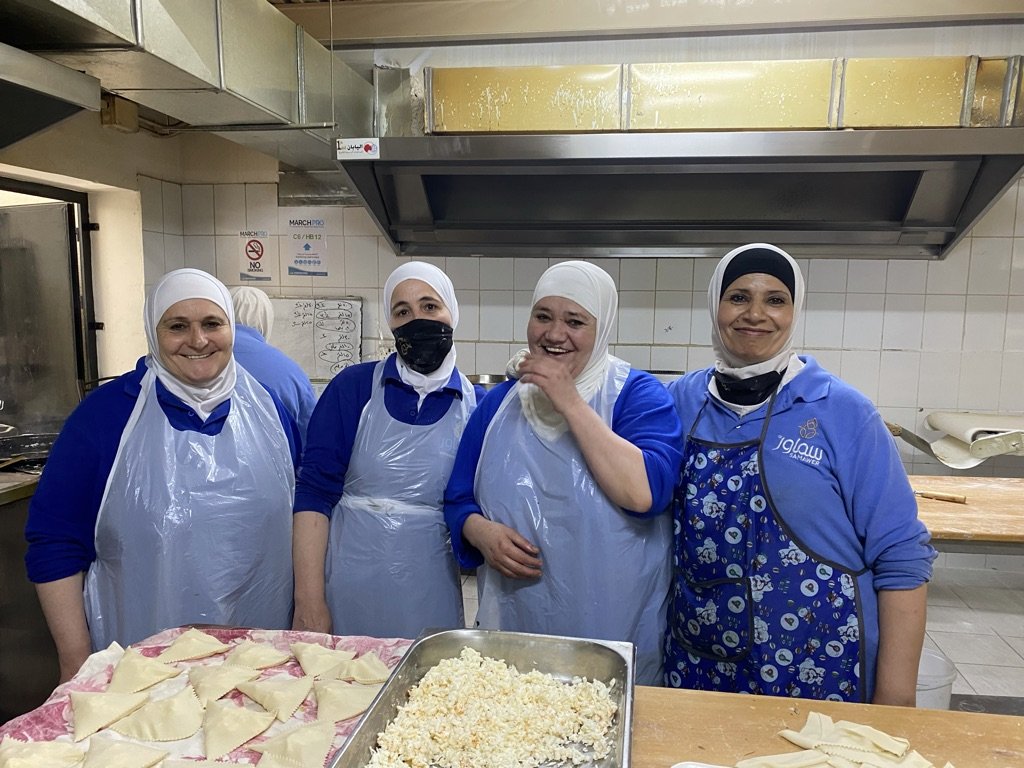Circassian Loqum
As promised, this week I’m sharing some of the recipes my Circassian husband’s family hold dear, in honor of Mother’s Day this past Monday. I’m actually thrilled as these recipes are ones I’ve never made before because when we’re in Amman we order them from the Circassian Women’s Association kitchen which has a charming cafe called Samawer attached to it. Forty almost exclusively Circassian women, work in the kitchens producing fresh and frozen Circassian and Arabic specialties which are available to eat in the cafe upstairs or for delivery (the Royal Palaces often order from them). Some of my favorites include Kibbeh, which is a mixture of bulgur wheat and minced lamb worked into a torpedo-like shape and then filled with more cooked minced lamb, onions, spices, and pine nuts before it’s fried. Of course there is Ships Ou Pasta, the chicken with a creamy walnut sauce that the Circassians are famous for. There are stuffed vine leaves, stuffed cabbage, delicious Mousakhan (sumac chicken with onions), Circassian cheese, shish barak (meat-filled dumplings). Lots and lots of delicate hand work with various doughs and swift creation of fiddly morsels goes on in that giant kitchen. Much, I would guess, learned from standing at the apron strings of mothers, aunties, and grandmothers, watching as they tirelessly created these same dishes throughout the years.
As I mentioned in my Instagram post, the Circassians came to Jordan from the Caucus Mountains from the 1860s onwards, when they were expelled from their homeland by the Tsar. They traveled through the then Ottoman Empire, most settling in Turkey but many carrying on as far as Jordan, Syria, and Palestine. There are about 125,000 Circassians in Jordan and while they are certainly Jordanian, they are proudly Circassian first and foremost. It’s through places like Samawer, its profits going to the Circassian school and other cultural institutions, that they are able to keep their amazing heritage alive.
My mother-in-law was the President of the Circassian Women’s Association for many years and when I visit she loves to take us to the restaurant and down into the busy kitchens where the ladies are always bustling around cooking. On each visit Auntie Suzanne introduces me to the women and they are eager to show me what they’re making. I remember not being able to speak to the women on my earlier visits, but on my last trip in September last year, I was surprised to re-watch the videos and hear myself speaking to them quite easily and understanding their replies. The women giggled and talked up a storm while they sat on stools, proud to show me their techniques.
Loqum are a not terribly sweet donut that is often eaten in the morning with a strong cup of black tea, some Circassian cheese, and spoonfuls of honey and homemade jams. I think that a little drizzle of rose water sugar syrup would be a terrific addition or maybe a hint of cardamom in the dough itself, but want to give you the recipe as it is traditionally done, and then you can decide if and how you’d like to modify it. The trickiest part in this recipe is the shaping, which I went to the Jumaeya specifically to learn how to do properly (you can watch the video on my Instagram post). It’s actually not that hard, but does take a minute to process. Of course these are best straight out of the oil, but I think they’re so good I’ll eat them any time.
Loqum
makes 50
1 litre whole milk
10g dry active yeast
1/2 cup water
2 eggs
1/4 cup plain yogurt
1/2 cup sugar
1 teaspoon salt
2 kg all-purpose flour
icing sugar to dust
Heat the milk just slightly to about 90-95F or 32-35C and sprinkle the yeast on top, stirring in. Now mix together all of the wet ingredients and do the same in another large bowl with the dry. After the yeast has activated, about 10 minutes, add it to the dry ingredients along with the wet. Stir it all together with a fork until the dough starts to come together and then knead for several minutes until you have a smooth, firm, ball of dough. Cover it with a towel and set aside in a warm place for 2 hours, until it’s doubled.
Once you’re ready to make the loqum, roll the dough out into a large rectangle about 1/4 inch thick. I then cut the dough into 2x4 inch rectangles and in the middle of each rectangle cut a small 1 inch slit. To form the loqum you simply pick up the rectangle and tuck one end under and up into the middle slit, pulling it up and through (see my video on Instagram post).
To cook, heat canola oil in a large heavy pot to 350F or 175C and add about 4 loqum to the pot at a time. They’ll puff up immediately and after they’re well-browned on one side, turn and allow the other side to cook. Remove to a paper towel to drain. Dust with icing sugar and serve.

